ALT.FUEL
Japan’s First Hydrogen Dual-Fuel Tug with Combustion Engine Launched

As part of the “Zero Emission Ships Project” sponsored by The Nippon Foundation, Japan last week launched its first hydrogen dual-fuel tug. The vessel is pioneering using a high-power internal combustion engine with the industry seeking to develop expertise in the emerging sector.
The new tug was launched by Tsuneishi Shipbuilding on March 28 and is the first vessel in Japan to be equipped with a high-power output hydrogen dual-fuel internal combustion engine. It also has a high-pressure hydrogen gas storage system with a large capacity. With facilities to store approximately 250kg of high-pressure hydrogen gas, Tsuneishi says it will be possible to maintain the same operational performance as when using conventional fuel while also making use of hydrogen fuel. In the unlikely event of failure of the hydrogen fuel system, the vessel can operate with only traditional marine fuels, thus ensuring the same level of safety as conventional vessels.
“We have successfully launched our first hydrogen-fuelled tugboat. We will utilize the know-how and design processes we have developed in the construction of hydrogen-fuelled tugboats, which require high power, in the construction of further new fuel vessels,” said Nishijima Takanori, General Manager of the Design Division and Managing Executive Officer of Tsuneishi Shipbuilding Co.
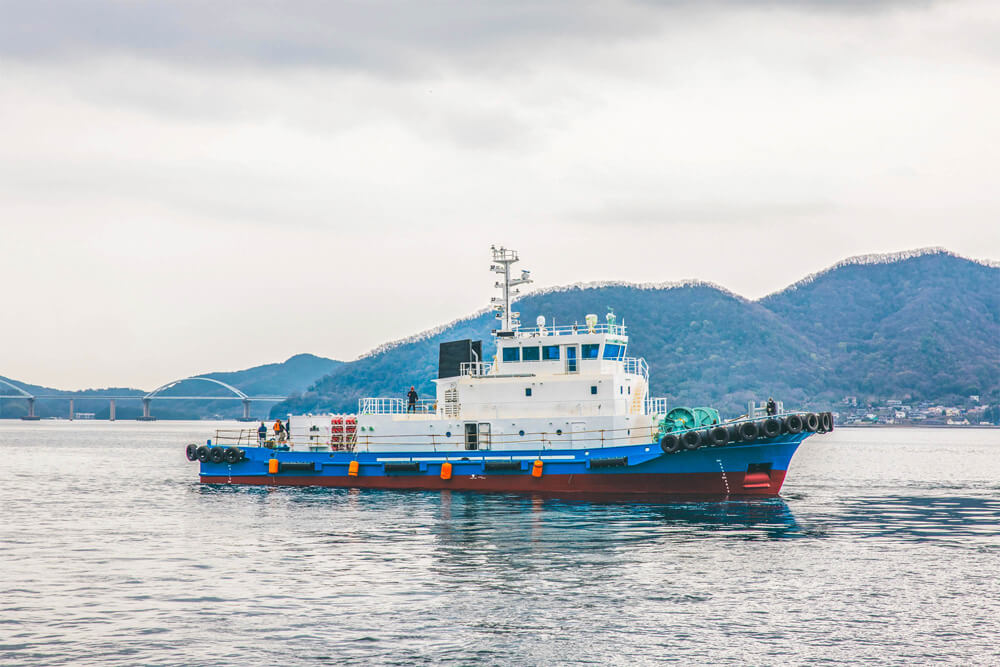
Japan's first hydrogen dual-fuel tug with an internal combustion engine (Tsuneishi Shipbuilding)
The shipbuilding notes that one of the challenges for tugboats is the need to be highly maneuverable and have high engine output to assist in berthing and opera operations of large vessels. This tugboat is installed with twin 12-cylinder hydrogen-blended engines (4,400 horsepower class), which will give it the needed capabilities. The vessel will be less than 300 gross tons with a length of 38 meters (125 feet).
The plan calls for operating with hydrogen in combination with traditional marine fuels. They are targeting reducing carbon dioxide emissions by approximately 60 percent compared to conventional tugboats that use traditional marine fuels.
To further enhance the project’s overall sustainability Tsuneishi is also incorporating “JGreeX” produced by JFE Steel Corporation, It is a green steel product that was used for all of its steel plates.
Many projects are focusing on hydrogen fuel cells instead of internal combustion engines as hydrogen remains a technology in development as a marine fuel. The Port of Antwerp-Bruges and the Savery family’s CMB.TECH launched what they said was the first hydrogen-fueled tug in 2023. Hydrotug 1 was also reported to be the largest vessel currently capable of operating solely on hydrogen. It is operating demonstrations in the port of Antwerp while CMB.TECH has developed other vessels including a crew transfer vessel using hydrogen.\
Stena Presents Futuro Concept RoRo that Would Reduce Energy Usage 20%
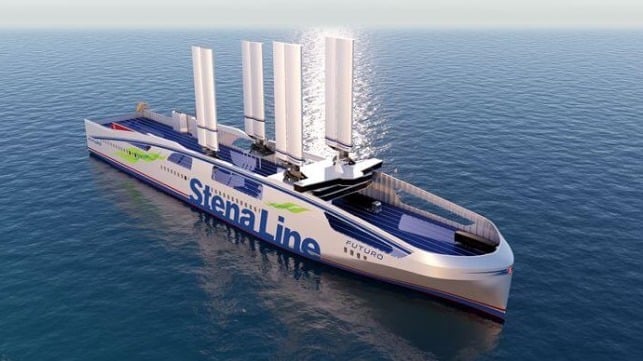
Stena Line, one of Europe's leading ferry companies and a pioneer with advanced designs, presented its latest thinking for Stena Futuro, a RoRo that would reduce energy usage by 20 percent or more. The company’s goal is an overall 30 percent reduction in its CO2 emissions by 2030.
“The mission is to develop the most efficient and competitive vessel possible for a specific cargo capacity, using today’s available technology. The goal is for the vessel to have the lowest fuel consumption on the market,” says Nicolas Bathfield, Project Manager at Stena Teknik, who has been involved in developing the concept.
Stena Futuro would be a 240-meter (787-foot) long RoRo vessel intended for transporting semi-trailers and cars. Stena Teknik, a resource within the group for all its business units, is exploring the full range of technologies to advance the efficiency of this next-generation vessel. The group is focused on newbuilds as well as the energy and digital transformation mostly in the maritime sectors.
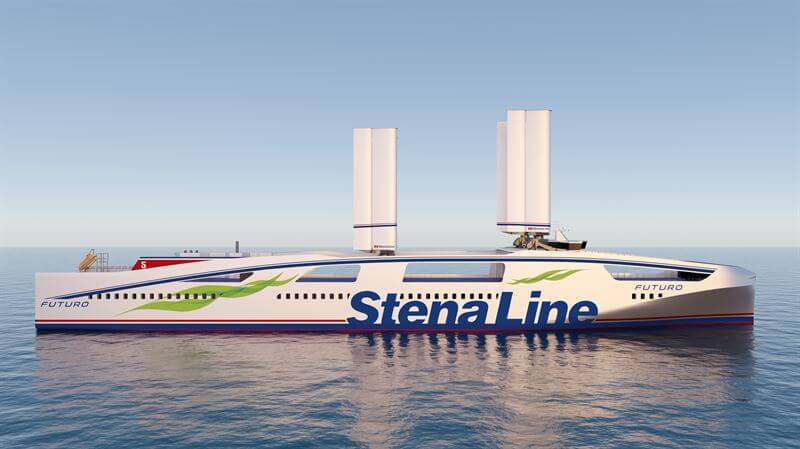
Stena Line's latest concept for the new generation of vessels uses a low and streamlined design to reach its ambitions. The hull and superstructure have been optimized to achieve the most efficient use of cargo space possible. At the same time, low weight and optimized hydro- and aerodynamics are central to achieving low fuel consumption. The hull of Stena Futuro would also be equipped with an air lubrication system.
The concept for Stena Futuro also includes four 40-meter (131-foot) tall wing sails, which can be retracted when needed — for example, when passing under a bridge. Recently, Stena’s developers, together with the Swedish research institute RISE, have conducted tests and simulations of the sails’ usage to document both energy savings and how the sails affect the ship’s maneuverability and safety.
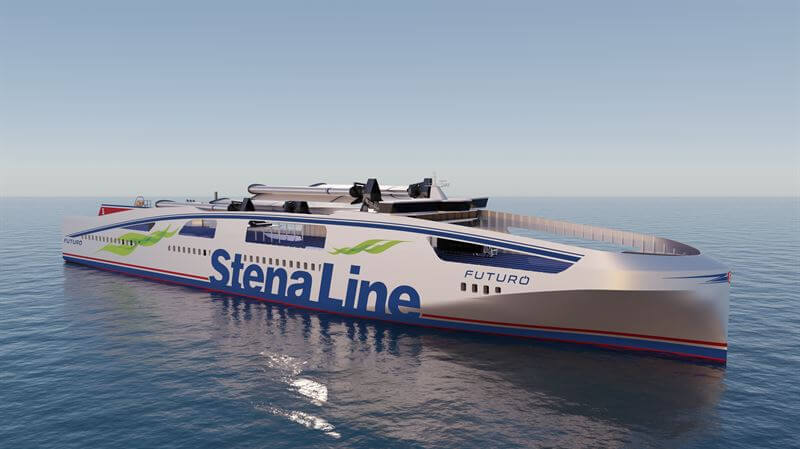
“The tests showed that Stena Futuro’s sails could potentially result in as much as 15 percent fuel savings. We also confirmed that the vessel meets all requirements for stability and maneuverability in scenarios such as sudden wind shifts or quick course changes,” says Bathfield.
The vessel would also have hybrid propulsion, batteries, and engines with low fuel consumption that can run on several different fuels. The battery system makes it ready to partly operate the vessel on electricity alone, for example, when entering and leaving ports. Solar panels will also contribute to the ship’s electricity needs. A waste heat recovery system will make it possible to reuse the hot exhaust gases from the ship’s engines to meet other onboard heating needs as well as supporting electric power generation.
Stena says the ship design will play a vital part in its future tonnage planning in the coming years. Currently, however, there is no finalized plan for the production of Stena Futuro.\
Norway’s First Bio-Methanol Feeders Enter Service
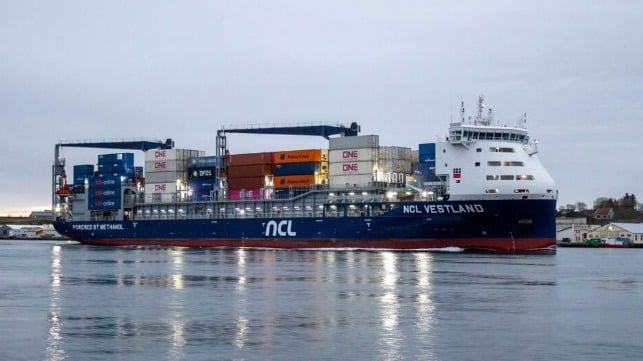
Norway marked a milestone in its efforts to be a leader in green shipping with the introduction of the first of two vessels that will be powered with bio-methanol. The containerships which are operating in a partnership between North Sea Container Line and MPC Container Ships will expand Norway’s trade with Europe while also lowering emissions.
NCL Vestland is the first of the two vessels and today, April 1, they celebrated the naming and entry into service of the ship, with her sister ship NCL Nordland to follow. The ships were ordered in 2023 under a program in part sponsored by the Norwegian government to advance green shipping. The project received NOK 13.7 million (US$1.3 million) in funding from Enova SF, the state enterprise owned by the Norwegian Ministry of Climate and Environment, and NOK 60 million (US$5.7 million) from the NOx fund (Næringslivets NOx-fond), the Norwegian business sector’s fund to reduce emissions.
The ships were built by China’s Taizhou Sanfu Ship Engineering and are fitted with dual-fuel engines capable of operating on conventional fuel or green methanol. The newbuilds will reduce NCL’s overall CO2 emissions by 50 percent, compared to the existing NCL fleet, when operating on diesel. In 2025, NCL will operate the vessels with a 5 percent blend of bio-methanol and the strategy is to gradually increase the bio-methanol going forward. NCL has signed an agreement with Equinor for the sourcing of the methanol and the vessels will be bunkering in Norway.
The hull, which is 149 meters (489 feet) in length, along with the propellers, and onboard systems are designed for maximum energy efficiency. The ships are each equipped with a 250 kWh battery pack and the capability to use shore power. Each ship has a capacity of 1,300 TEU. They feature an "Open Top" design which the companies highlight minimizes the need for crew on deck, further enhancing safety. The electric cranes on deck are designed to enhance efficiency when in port, independent of onshore infrastructure providing increased flexibility in the ports they can access.
The plan calls for three older vessels to be replaced by the two new ships, each of which has a 40 percent greater container capacity compared to the ships currently operating the feeder service. As such, NCL reports that the vessels will achieve a 63 percent reduction in energy capacity per TEU per nautical mile.
The ships are operating under a 15-year chart to NCL and have long-term contracts for transportation from Norway including with Elkem, a provider of silicon-based materials. With stops at key industry hubs in Norway, Elkem says they will enable larger weekly shipments of its silicon products to European customers in sectors such as automotive manufacturing, construction, renewable energy, and the defense industry, and enable growth and jobs along the Norwegian coast.
“These state-of-the-art vessels will play a significant role in transporting Norwegian goods and strategic silicon metals and materials to the continent, cementing Norway’s position as an important and reliable supplier of critical inputs for European industries,” said Morten Viga, CFO of Elkem.
The vessel will operate between Stokmarknes and Rotterdam, Bremerhaven, calling at Salten, Mo i Rana, Orkanger, Averøy, Ålesund, Svelgen, Bergen, Haugesund, and Tananger. It will supply Europe with strategically important minerals, fish food, and other commodities via the ports of Bremerhaven and Rotterdam.
NCL highlights this is the first of three zero-emission capable vessels it will be introducing. In addition to the two methanol-fueled feeders, NCL will operate the world’s first ammonia-powered container vessel in a project with ammonia-producer Yara International and its subsidiary Yara Clean Energy and the support of the Norwegian Government through its Enova investment fund. The ammonia-powered feeder project was announced in 2023 with a target of starting operations in 2026.
No comments:
Post a Comment